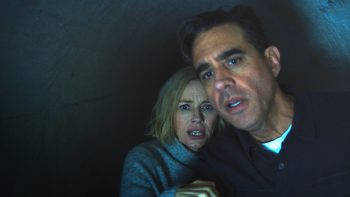by Maureen McCabe –
Buying a new house should be a happy, celebratory experience but as anyone who’s navigated the high-stakes, competitive real estate market knows, it can turn into a nerve-wracking, finance- busting disaster. Ryan Murphy’s The Watcher, a new series currently streaming on Netflix, takes the creepy, real- life events involving one of the most traumatic home purchases ever and turns it into a seven- episodes long descent into terror.
As detailed in the 2018 The New York Magazine/ The Cut article by Reeves Wiedeman, Derek and Maria Broaddus, re-envisioned as Dean and Nora Brannock in the show, bought what they thought would be their dream home at 657 Boulevard in idyllic Westfield, New Jersey back in 2014. A tony town that bills itself as “safe as Mayberry,” Westfield is known for its stately old homes and beautiful landscaping. The couple’s initial

excitement soon turned to foreboding. Before they even moved in, they received an ominous letter from someone calling themselves The Watcher. “657 Boulevard has been the subject of my family for decades now and, as it approaches its 110th birthday, I have been put in charge of watching and waiting for its second coming,” began the first letter. “My grandfather watched the house in the 1920s and my father watched in the 1960s. It is now my time. Do you know the history of the house? Do you know what lies within the walls of 657 Boulevard? Why are you here? I will find out.” Even more disturbingly, The Watcher mentioned the Broadduses’ two young children. “Do you need to fill the house with the young blood I requested? Better for me. Was your old house too small for the growing family? Or was it greed to bring me your children? Once I know their names I will call to them and draw them to me.”
More letters followed, amping up the family’s terror and plunging them into a nightmarish mystery. Who was responsible for the letters, which it turned out the previous owners had also received once, and disregarded? Should they finish the renovations they’ve started and make the house their own, or should they cut ties with the property altogether? In the show, the Brannock’s have sunk every cent they have into the house and whether or not to sell the house at a loss is a painful decision with far-reaching consequences.

Murphy takes the basic facts of the case and mixes it with his trademark camp/shock gore, violence (including two animal deaths), and sinister red herrings. The result is a twisty, suspenseful ride that will keep viewers hooked while also frustrating them. He serves up several possible candidates as The Watcher. Perhaps it someone who is angry about being outbid on the house. Or maybe it is a member of the way-too invested Historical Preservation Society, headed up by pigtailed, oddball next door neighbor Pearl Winslow. Or perhaps it is the aggressively nosy neighbors Mitch and Mo, who may or may not be members of a blood-drinking cabal. Or maybe it is Dean himself, in over his head and trying to extricate himself from a house he just can’t afford, an accusation the Broadduses themselves faced.The cast is uniformly top-notch. Naomi Watts and Bobby Cannavale shine as the handsome, well-manicured couple whose loving marriage and mental health start to disintegrate under the stress of The Watcher’s

letters. Mia Farrow, as the pigtailed Pearl Winslow, and Terry Kinney as her Boo-Radley-esqe brother Jasper, are wonderfully off-putting. Jennifer Coolidge is great as the real estate agent from hell and Noma Dumezweni brings a fabulous panache to her role as the private investigator Theodora Bird that the Brannocks hire in hopes of solving the mystery of the watcher and those increasingly threatening letters.
Viewers hoping to watch a skillful investigation that leads to the discovery of The Watcher will be disappointed. In reality, whoever is behind the person of The Watcher remains unknown. In both the show and real life, the investigation into the case seems desultory at best; the real life the mayor of Westfield assured residents the investigation into the case was “exhaustive,” but neighbors living in very close proximity to 657 Boulevard said they were never interviewed. The show likewise shows the police department as being disinterested at best, and complicit at worst. The show ends with shots of more than one of the possible suspects engaging in behavior that could reasonably lead the viewer to believe they are the writer orchestrating the letter campaign, or at least have recently taken up the mantle of The Watcher, but it never makes a definitive case for any of them. If such open-ended conclusions are not for you, you will most likely be exasperated by The Watcher. But viewers who are looking for a riveting, menacing dive into their deepest anxieties will find it rewarding. Primal fears about safety and privacy and how much you can really know about your neighbors are laid bare, and fans of The Watcher may find the housing market even more frightening than generally thought.








